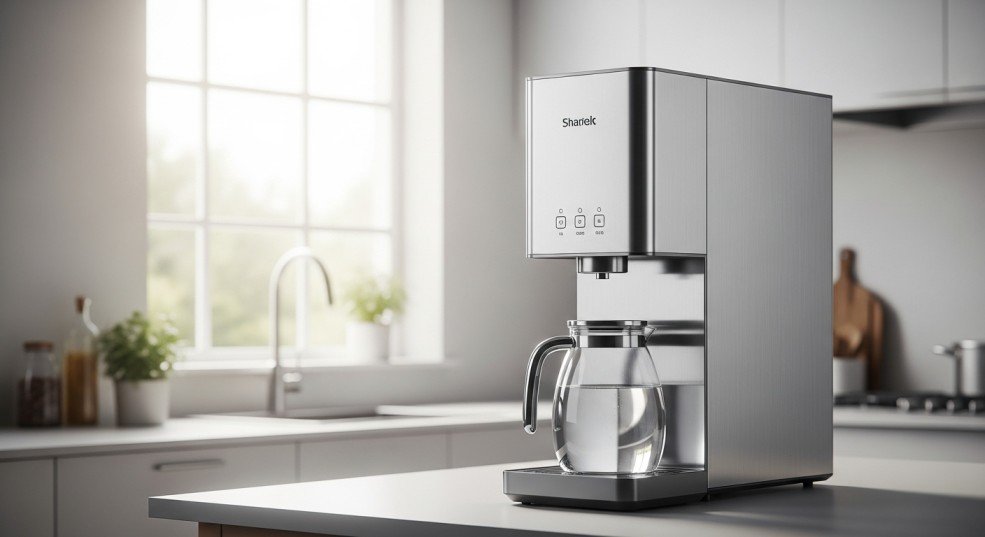
Best Maintenance Tips for Long-Lasting Water Purifiers, Filters, and Ionizers
- Maintenance & Care
- July 24, 2025

Clean water is not a luxury—it’s a necessity, especially in growing cities like Kathmandu. Water purifiers, filters, and ionizers have become standard in most Nepalese homes and businesses. However, owning these systems isn’t enough. Regular care and proper maintenance ensure that they work efficiently for years.
In this detailed guide, you’ll discover practical, easy-to-follow tips for keeping your purifier system in peak condition. Whether it’s a dry season, dusty or monsoon silt, the guidelines given here are specific to Nepal’s climate.
From cleaning filters to choosing a trusted supplier of water filters, purifiers, and ionizers, everything is covered. Let’s see how you can protect your investment and drink clean, safe, alkalized water every day.
Key Insights
- Regular Maintenance Prevents Issues
Monthly checks for leaks, water clarity, and system condition help avoid health risks and costly repairs, especially in dusty, polluted Kathmandu water. - Clean and Replace Filters on Time
Rinse sediment filters monthly, change carbon filters every 6–8 months, and keep a log to replace filters before clogging affects water quality. - Adjust Care by Season
Inspect filters more frequently during monsoon, sanitize post-monsoon, and remove dust plus maintain pumps in the dry season for consistent performance. - Maintain Ionizers Properly
Descale regularly, run cleaning cycles monthly, and replace filters as recommended to keep alkaline water quality high and prevent damage. - Use Professionals When Needed
Do basic cleaning yourself, but get annual professional service for complex tasks like pump calibration and repairs to ensure warranty and system longevity.
Table of Contents
Water Purifier Maintenance Basics
Maintenance starts with an idea of what you’re working with.
In the majority of Kathmandu neighbourhoods, dust, rust, sediment, and bacteria contaminate the city’s water supply. This is a burden on your filtration system, especially if it operates daily in a home or commercial setting.
Basic Maintenance Steps
- Check the outside of the system once a month.
- Inspect pipes for leaks, strange noises, or changes in pressure.
- Monitor water taste and clarity—small changes are a warning signal.
- Make sure the system is not exposed to heat, direct sunlight, or moisture-laden regions.
Daily maintenance prevents water-borne illnesses for Nepali residents. It minimizes downtime and repair costs in small offices or local cafés.
When many people depend on a single machine, issues must be identified early. Educating family members or staff about how the system works can do wonders. They should know how to switch off the system in emergencies and who to contact for help.
In short, consistent water purifier maintenance isn’t just technical—it’s essential for your health and peace of mind.
Essential Routine Water Filter Care Tips to Extend Purifier Lifespan
Every water filter has a life, and taking care of it means you’ll get the most out of your investment. The filters inside your system work non-stop to trap impurities like sand, chlorine, iron, and bacteria. But over time, these filters get clogged.
Here’s what you can do:
- Check filters monthly: If your area has high TDS (Total Dissolved Solids) or hard water, do it more frequently.
- Rinse sediment filters: Use clean running water. Use a soft brush to remove any visible dirt.
- Replace activated carbon filters: Change every 6–8 months depending on usage. These remove chlorine and bad taste.
- Backwash sand filters: Wash the multi-stage systems to improve flow and keep impurities from going deeper.
If your filter has a transparent casing, examine the cartridge colour. Brown or black discoloration means it is due for service. Also, check the flow rate. If water becomes much more sluggish, the filter is likely clogged.
Having a notebook or electronic log assists in monitoring how long each filter has been active. This precludes waiting until water quality decreases.
Remember: Water filter care = fewer replacements, fewer breakdowns, and a longer system life.
Checking and Cleaning Pre-Filters
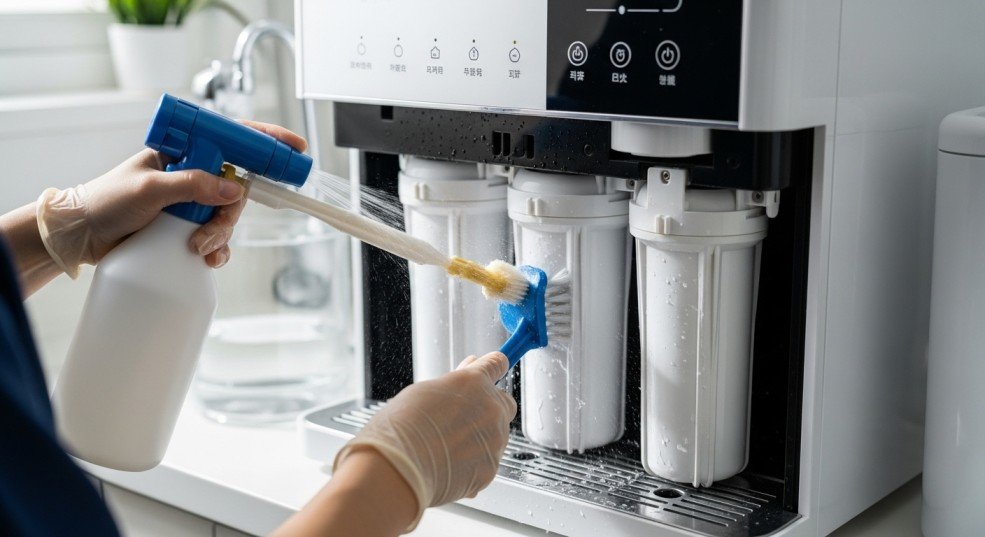
The pre-filter is the often-overlooked aspect of your purifier system. It captures the large particles—dust, mud, sediment—before water even touches the RO membrane or ionizer plates. So, if the pre-filter is clogged, the entire system gets affected.
Here’s how to maintain it:
- Turn off the water supply before disassembling the unit.
- Open the pre-filter casing carefully. Wear gloves if needed.
- Rinse the filter thoroughly. Use a hose with strong pressure or clean tap water.
- Let it dry completely if you plan to reuse it. If it’s worn out, replace filters immediately.
- Sanitize the housing with a mild bleach solution (1 tbsp per gallon of water), rinse well.
Repeat every 2 months instead of 3 if the environment is high-dust or if the water pipes are very old. If the pre-filter isn’t cared for, it shunts all of the sediment to the next stage, reducing effectiveness and wearing out prematurely.
Maintaining your pre-filters ensures general water purifier maintenance and reduces your need for frequent professional maintenance in the future. Think of it as a small thing with tremendous impact.
On-Time Replacing of Filters: The Easy Way to Replace Filters
There’s no substitute for on-time filter replacement. Even if water looks clean, overdue filters can let fatal particles and microbes pass through.
Every one of your filters has an expiration date:
- Sediment filters – Replace every 6 months
- Carbon filters – Every 6 to 8 months
- RO membranes – Every 2 to 3 years
- UV lamps (if applicable) – Once a year
To replace filters without a mess:
- Turn off your water supply and unplug the machine.
- Let pressure drop before unscrewing any part.
- Remove the old filter. Discard responsibly.
- Insert the new filter in the correct direction (look for flow arrows).
- Sanitize the o-rings with silicone grease to avoid leakage.
- Tighten gently—don’t overtighten.
- Flush the system for 10–15 minutes before use.
Record the replacement date and set a 6-month reminder on your phone. Routine replacements guarantee clean, healthy water and a longer-lasting purifier.
Troubleshooting Common Issues in Ionization System Maintenance
Ionizers add value to your purifier by producing alkaline water. But just like any other electrical product, they’re prone to some issues—especially in environments with hard water, like in Kathmandu.
Common Problems and Fixes
- Low pH output: Scale may be covering the electrode plates. Descaling is necessary.
- Reduced flow rate: The inlet filter or tubing might be blocked. Clean or replace.
- Machine won’t power on: Check electrical connections, wall plug, or internal fuses.
- Incorrect pH readings: Calibrate the system or check the sensor’s cleanliness.
For basic maintenance, operate the self-cleaning cycle regularly. If non-automatic, flush with citric acid monthly via the unit. For more serious issues, do not attempt DIY repair. Instead, engage a technician experienced with Kathmandu water solutions and water conditions here.
Keeping pH logs, service history, and even screenshots of display malfunctions lets you track performance and catch faults early. Correct ionization system repair saves time and preserves the machine’s high-performance life.
Deep Sanitizing and Cleaning
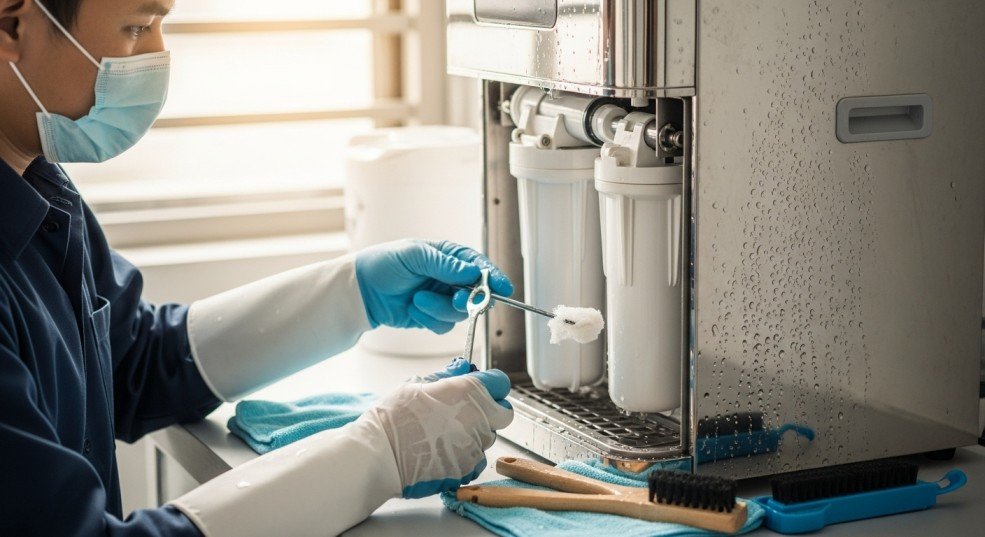
Deep cleaning is when you give your system a fresh start. Even with new filters, bacteria, algae, and mould can creep into tubes, tanks, and housings.
Follow this procedure every 6–12 months:
For Storage Tanks
- Drain the tank entirely.
- Fill with sanitizing solution (1 tablespoon bleach per gallon of water).
- Wait 30 minutes.
- Rinse well so that no bleach smell is left behind.
For Internal Tubing
- Inspect for discoloration or slime.
- Replace if the tubing is over 2 years old.
- Run the cleaning solution through the system and flush clean water afterwards.
For RO Membranes
- Use manufacturer-recommended acid/alkaline cleaners.
- Never use harsh chemicals or soap.
- Flush thoroughly before re-use.
These steps keep your system safe and in fantastic working condition. Sanitizing also destroys invisible foes that regular filters will not stop. Clean machines = clean water. Simple as that.
Professional vs. DIY Maintenance
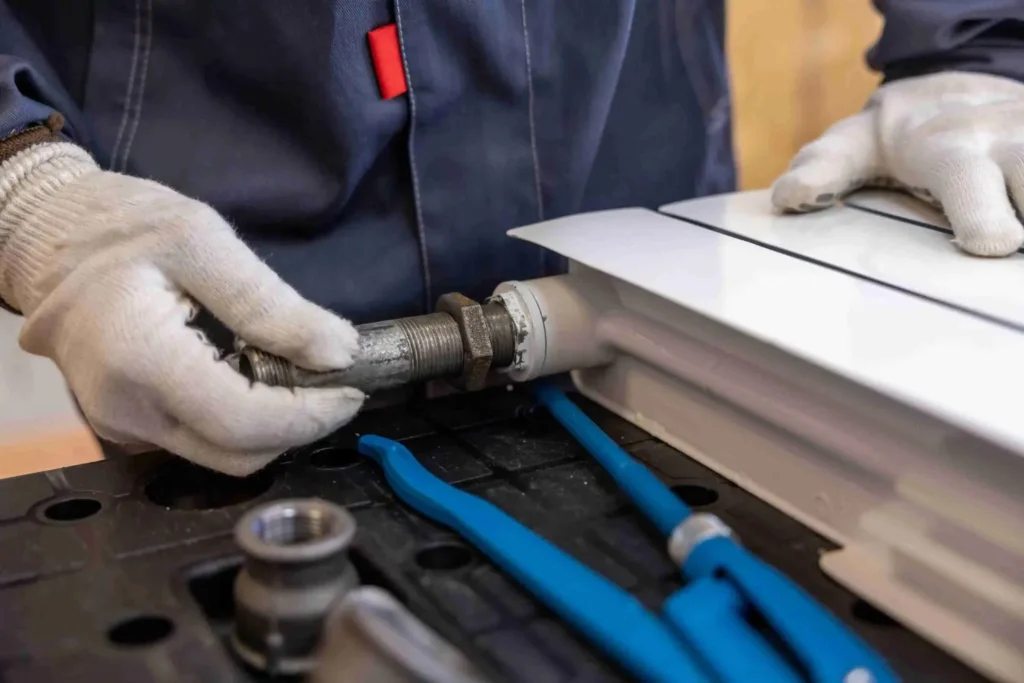
DIY maintenance does have its applications. You’re able to clean filters, wash housings, and verify general output. But certain tasks are best left to the professionals.
Here’s when to hire a professional installation and maintenance service:
- Annual system checks – For pump calibration, membrane efficiency, and electronic control testing
- Ionizer repairs – Involve sensitive electronics and pH balancing
- Pressure or flow issues – Often require tools and meters you don’t have
- Warranty servicing – Must be done by certified personnel
A trained technician possesses pressure gauges, TDS meters, and leak detector gear. They also understand how to customize systems to change with evolving Kathmandu water solutions, especially with seasonal fluctuations.
Do not attempt your own repair for serious problems. Professional maintenance ensures safety, quality, and long-term reliability.
Maximizing the Use of Chanson Alkaline Water Ionizer: How to Run and Maintain it in Top Condition
Chanson Alkaline Water Ionizers are built with precision. They can produce pH levels of 2.5 to 11.5—ideal for cleaning, drinking, and detoxing. But some maintenance is necessary to keep them strong.
Follow these brand-specific guidelines:
- Use only citric acid or Chanson descaler for cleaning ion plates.
- Don’t skip the cleaning cycle—run it at least once a month.
- Replace the internal filter every 6–10 months for optimal mineral output.
- Wipe the touch panel with a dry cloth regularly.
- Avoid placing the machine near extreme temperatures or direct sunlight.
Chanson machines are 100% chemical-free, using solely natural processes. That makes them very safe—but it does mean that scale buildup is more probable in hard water.
Routine water purifier maintenance keeps your Chanson ionizer running to supply you with safe, alkalized water that improves digestion, metabolism, and energy.
Seasonal Maintenance Checklist
In Nepal, the weather impacts water quality. So your maintenance should change with the seasons.
During Monsoon (June–September)
- Inspect filters every two weeks.
- Use coarse sediment pre-filters to handle muddy water.
- Check for leaks caused by high pressure.
Post-Monsoon (October)
- Replace filters that clogged faster during the rains.
- Sanitize the system completely.
- Clean storage tanks and UV chambers.
During Dry Season (November–May)
- Inspect booster pumps and install pressure regulators.
- Remove dust build-up on outer casings and ventilation grills.
- Ensure UV lamps aren’t covered with residue.
Regular maintenance according to season keeps water quality intact and avoids mid-year breakdowns. Think of it like keeping your system in sync with nature’s rhythm.
Selecting a Reliable Water Filter, Purifier, and Ionizer Supplier
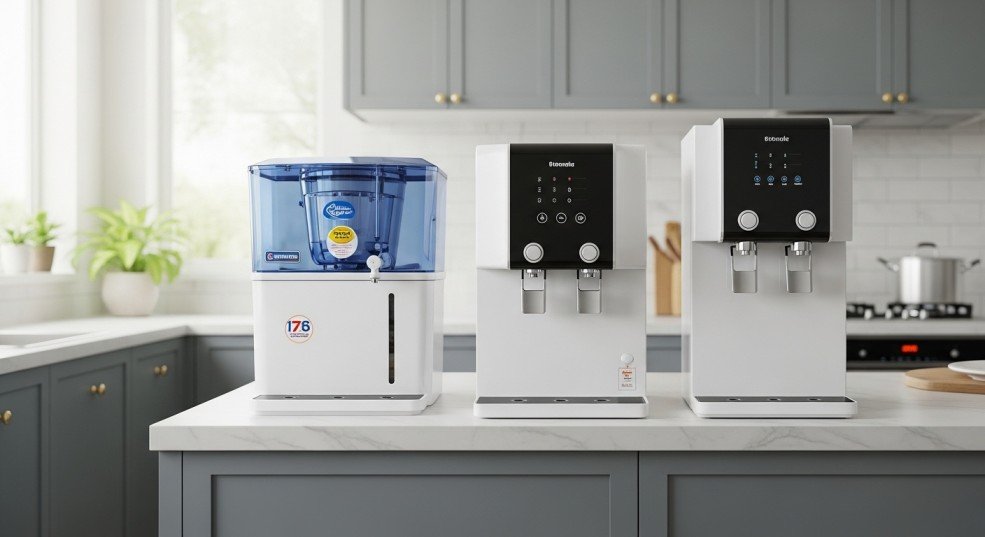
Behind every reliable system is a reliable supplier. SC Incorporated Pvt. Ltd., Tripureshwor, Kathmandu, in Nepal, is a top-rated and reliable supplier of water filters, purifiers, and ionizers!
We proudly offer:
- Chanson USA No. 1 Alkaline Water Ionizer (FDA & Medical Grade Certified)
- Custom installations for both homes and businesses
- Complete maintenance packages with OEM filters and fast service
- Expert help with ionization system repair and upgrades
Request professional installation and maintenance service today and keep your water system worry-free.
Frequently Asked Questions (FAQs)
1. How often should I replace water purifier filters in Nepal?
Every 6 to 12 months, depending on water quality and usage.
2. What causes low pH in my alkaline water machine?
Scale buildup or worn-out electrodes—run a descaling cycle and check filters.
3. Is professional maintenance necessary for home systems?
Yes—at least once a year to ensure optimal performance and warranty compliance.
4. Can I clean filters with soap or detergent?
No, always use clean water or manufacturer-recommended solutions.
5. What is the ideal pH range for drinking alkaline water?
Between 8.5 to 9.5 is optimal for daily drinking.
6. How long does a Chanson ionizer last?
With proper care, it can last over 10 years.
7. Do monsoons affect water purifier performance?
Yes, due to increased sediment and pressure fluctuations, extra care is needed during these months.
